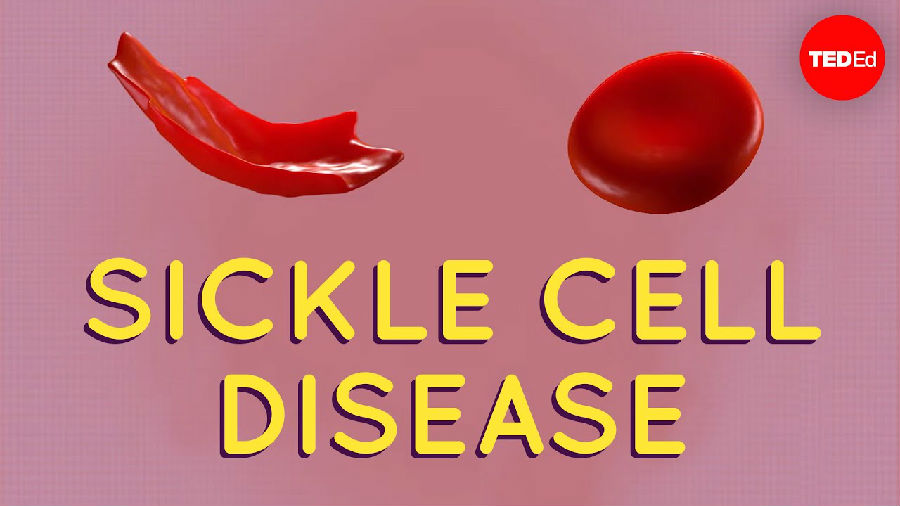What shape are your cells? Squishy cylinders? Jagged zig-zags?
你的细胞是什么形状的?软粘的圆柱体?还是锯齿状的之字形?
You probably don't think much about the bodies of these building blocks, but at the microscopic level, small changes can have huge consequences.
你可能不太会想这些基本构体的具体形状,但在微观层面,微小变化会产生巨大的后果。
And while some adaptations change these shapes for the better, others can spark a cascade of debilitating complications.
虽然一些适应性改变形状会变得更好,但其他适应性改变会引发一连串的抑制性并发症。
This is the story of sickle-cell disease.
这是镰状细胞病的故事。
Sickle-cell disease affects the red blood cells, which transport oxygen from the lungs to all the tissues in the body.
镰状细胞病影响红血球,红血球将氧气从肺部输送到体内的所有组织。
To perform this vital task, red blood cells are filled with hemoglobin proteins to carry oxygen molecules.
为了完成这项重要任务,红血球内充满了携带氧分子的血红蛋白。
These proteins float independently inside the red blood cell's pliable, doughnut-like shape,
这些蛋白质独立漂浮在红血球柔韧、甜甜圈般的形状内,
keeping the cells flexible enough to accommodate even the tiniest of blood vessels.
让红血球保持足够的灵活性,即使是最微小的血管也能通过。
But in sickle cell disease, a single genetic mutation alters the structure of hemoglobin.
但在镰状细胞病中,单一的基因突变改变了血红蛋白的结构。
After releasing oxygen to tissues, these mutated proteins lock together into rigid rows.
这些突变的蛋白质向组织释放氧气后,就锁成整齐的行。
Rods of hemoglobin cause the cell to deform into a long, pointed sickle.
血红蛋白组成的棒状物,使细胞变形为长而尖的镰刀。
These red blood cells are harder and stickier, and no longer flow smoothly through blood vessels.
这些红血球变得更硬、更粘,不再能顺利地流过血管。
Sickled cells snag and pile up -- sometimes blocking the vessel completely.
镰状细胞留在那里并堆积起来--有时会堵塞整个血管。
This keeps oxygen from reaching a variety of cells,
这会造成氧气无法送达各种细胞,
causing the wide range of symptoms experienced by people with sickle-cell disease.
产生镰状细胞病患者所经历的多种症状。
Starting when they're less than a year old, patients suffer from repeated episodes of stabbing pain in oxygen-starved tissues.
患者从不到一岁开始,就饱受缺氧组织中反复发作刺痛感的折磨。
The location of the clogged vessel determines the specific symptoms experienced.
血管堵塞的位置,决定了患者所经历的具体症状。
A blockage in the spleen, part of the immune system, puts patients at risk for dangerous infections.
脾脏作为免疫系统的一部分,它的堵塞会使患者面临危险感染的风险。
A pileup in the lungs can produce fevers and difficulty breathing.
肺部的镰状细胞堆积,会引起发烧和呼吸困难。
A clog near the eye can cause vision problems and retinal detachment.
眼睛附近的堵塞,会导致视力问题和视网膜脱离。
And if the obstructed vessels supply the brain the patient could even suffer a stroke.
如果供应大脑的血管堵塞了,患者甚至会中风发作。
Worse still, sickled red blood cells also don't survive very long -- just 10 or 20 days, versus a healthy cell's 4 months.
更糟的是, 镰状红血球无法存活很久--只有10或20天,而健康细胞可以活4个月。

This short lifespan means that patients live with a constantly depleted supply of red blood cells; a condition called sickle-cell anemia.
短暂的寿命意味着,患者的红血球供应不断枯竭;这就是被称为镰状细胞性贫血的疾病。
Perhaps what's most surprising about this malignant mutation is that it originally evolved as a beneficial adaptation.
可能这种恶性突变最令人惊讶的是,它最初进化竟然是良性适应。
Researchers have been able to trace the origins of the sickle cell mutation to regions historically ravaged by a tropical disease called malaria.
研究人员已追踪到镰变起源,源于历史上被热带疾病疟疾破坏的地区。
Spread by a parasite found in local mosquitoes,
经由当地蚊子身上发现的寄生虫传播,
malaria uses red blood cells as incubators to spread quickly and lethally through the bloodstream.
疟疾用红血球作为孵化器,迅速而致命地通过血液传播。
However, the same structural changes that turn red blood cells into roadblocks also make them more resistant to malaria.
然而,将红血球变成路障的同样的结构变化,也使他们对疟疾具有更强的抵抗力。
And if a child inherits a copy of the mutation from only one parent,
如果孩子只从一个家长那里继承了突变的基因,
there will be just enough abnormal hemoglobin to make life difficult for the malaria parasite,
就会有足够的异常血红蛋白,让疟原虫难以生存,
while most of their red blood cells retain their normal shape and function.
而他们的大多数红血球保持正常的形状和功能。
In regions rife with this parasite, sickle cell mutation offered a serious evolutionary advantage.
在这种寄生虫流行的地区,镰变提供了关键的进化优势。
But as the adaptation flourished, it became clear that inheriting the mutation from both parents resulted in sickle-cell anemia.
但随着适应性的不断发展,很明显,从父母双方继承突变的孩子,会得镰状细胞性贫血。
Today, most people with sickle-cell disease can trace their ancestry to a country where malaria is endemic.
如今,多数患有镰状细胞性贫血的人,其祖先可追溯到疟疾流行的国家。
And this mutation still plays a key role in Africa, where more than 90% of malaria infections occur worldwide.
这种突变在非洲仍然发挥着关键作用,其中90%以上的疟疾感染发生在全球范围内。
Fortunately, as this "adaptation" thrives, our treatment for sickle cell continues to improve.
幸运的是,随着这种“适应”的蓬勃发展,对镰状细胞的治疗也在继续改进中。
For years, hydroxyurea was the only medication available to reduce the amount of sickling, blunting symptoms and increasing life expectancy.
多年来,羟基脲是唯一可用药,它能减少镰变细胞数量、减缓症状,并延长寿命预期。
Bone marrow transplantations offer a curative measure, but these procedures are complicated and often inaccessible.
骨髓移植提供了一种治疗措施,不过这些过程很复杂,往往无法实现。
But promising new medications are intervening in novel ways,
但给人希望的新药物正以新颖方式干预治疗,
like keeping oxygen bonded to hemoglobin to prevent sickling, or reducing the stickiness of sickled cells.
比如把氧气粘合到血红蛋白上,防止红细胞镰变,或降低镰状细胞的粘性。
And the ability to edit DNA has raised the possibility of enabling stem cells to produce normal hemoglobin.
而且,编辑DNA的能力提升了使干细胞产生正常血红蛋白的可能性。
As these tools become available in the areas most affected by malaria and sickle cell disease,
随着这些工具的出现,在受疟疾和镰状细胞病影响最严重的地区,
we can improve the quality of life for more patients with this adverse adaptation.
针对这些携带这种不利的适应性改变的患者,我们可以提高他们的生活质量。


